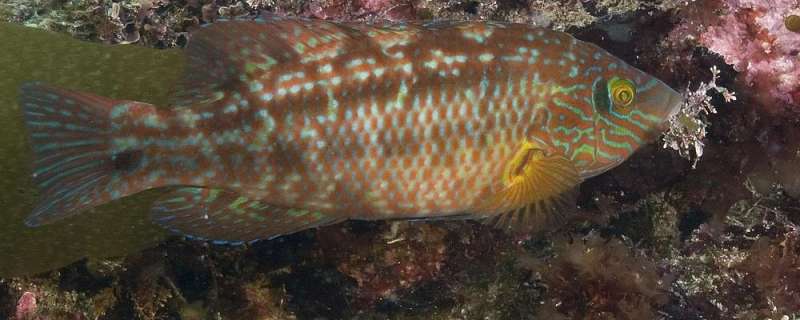Cleaner fish from salmon farming affect wild populations

A growing demand for cleaner fish in salmon farms raises concerns about overfishing and human-mediated geneflow to wild populations. A recent study reveals that up to 20 percent of the local populations of corkwing wrasse in mid Norway may constitute escapees and hybrids.
Every year, millions of wrasses are caught along the Swedish and Norwegian coasts, and transported to salmon farms for parasite control. Effects on the wild harvested populations, and the risks from cleaner fish escaping the farms, are poorly investigated.
Two recently published studies take a closer look at how the current fishery is affecting source populations and ecosystems, and to what degree translocated fish are escaping and mixing with populations outside the fish farms.
Translocation affect genetic composition
"We created a panel of genetic markers which we used to identify and quantify the number of escapees and hybrids along the Norwegian coast. Our results show that the introduction of southern genetic material at the northern edge of the species distribution range has altered the local genetic composition. This could obstruct local adaptation and further range expansion," says one of the authors, Ellika Faust at Tjärnö Marine Laboratory, University of Gothenburg.
Over the last decade, the number of cleaner fish used in Norwegian salmon aquaculture has increased from 1.7 million in 2008, to 61 million in 2019. Approximately 1 million wild-caught corkwing, goldsinny, and ballan wrasse are fished yearly on the Swedish west coast and exported to Norway for use in the fish farms.
"We don´t know how catching wild cleaner fish may be affecting local stocks and ecosystems in Skagerrak. Wrasses were not previously considered a commercial species and information on stock structure and population dynamics is scarce," says Ellika Faust.
Monitoring is needed
On the Norwegian Skagerrak coast, local wrasse populations have begun to show signs of depletion. To test if the fishery has led to stock depletion in Sweden, and to provide knowledge and recommendations to support ecosystem-based management for wrasse fisheries, Ellika Faust and her colleagues compared fished and non-fished areas in Sweden.
No visible signs of stock depletion or altered size structure were detected at the current level of fishery. But the fact that wrasses are an important component of coastal algal belt ecosystem, calls for caution.
"Our study provides knowledge and recommendations to support ecosystem-based management for wrasse fisheries in Sweden as well as a baseline for future monitoring. Something that is very much needed, as the demand for wrasse is unlikely to decrease in the near future," says Ellika Faust.
"In order to continue using cleaner fish in aquaculture it's important to develop a sustainable management. We should neither overexploit local stocks nor alter existing populations or ecosystems in the final destination."
More information: Ellika Faust et al. Not that clean: Aquaculture‐mediated translocation of cleaner fish has led to hybridization on the northern edge of the species' range, Evolutionary Applications (2021). DOI: 10.1111/eva.13220
Sarah J Bourlat et al. Wrasse fishery on the Swedish West Coast: towards ecosystem-based management, ICES Journal of Marine Science (2020). DOI: 10.1093/icesjms/fsaa249
Provided by University of Gothenburg


















